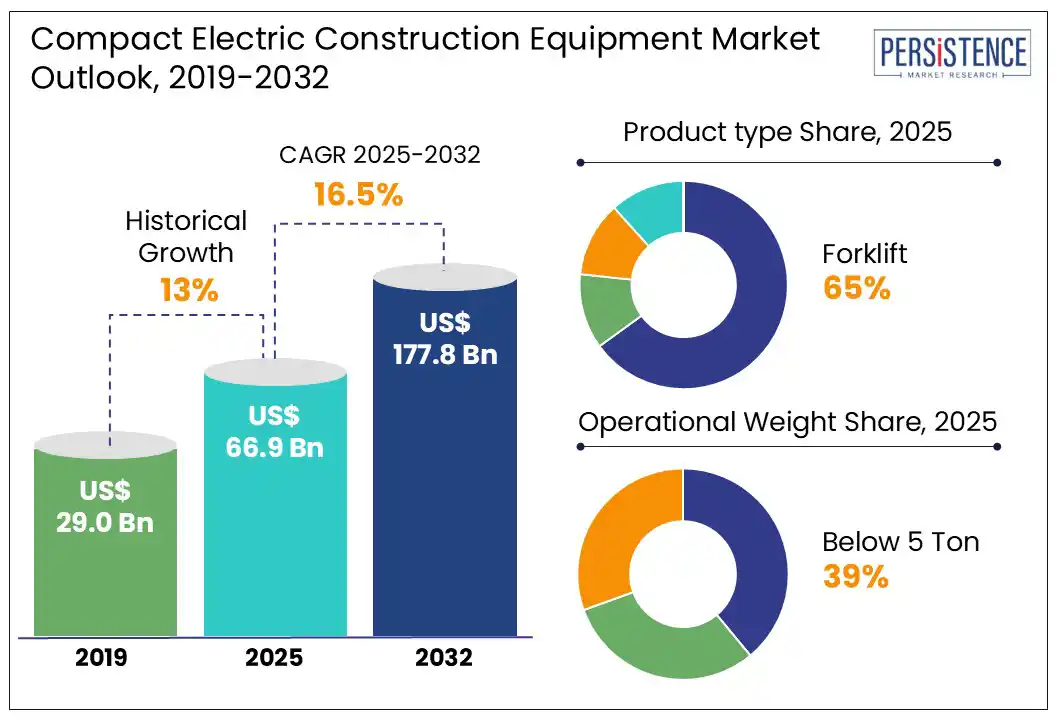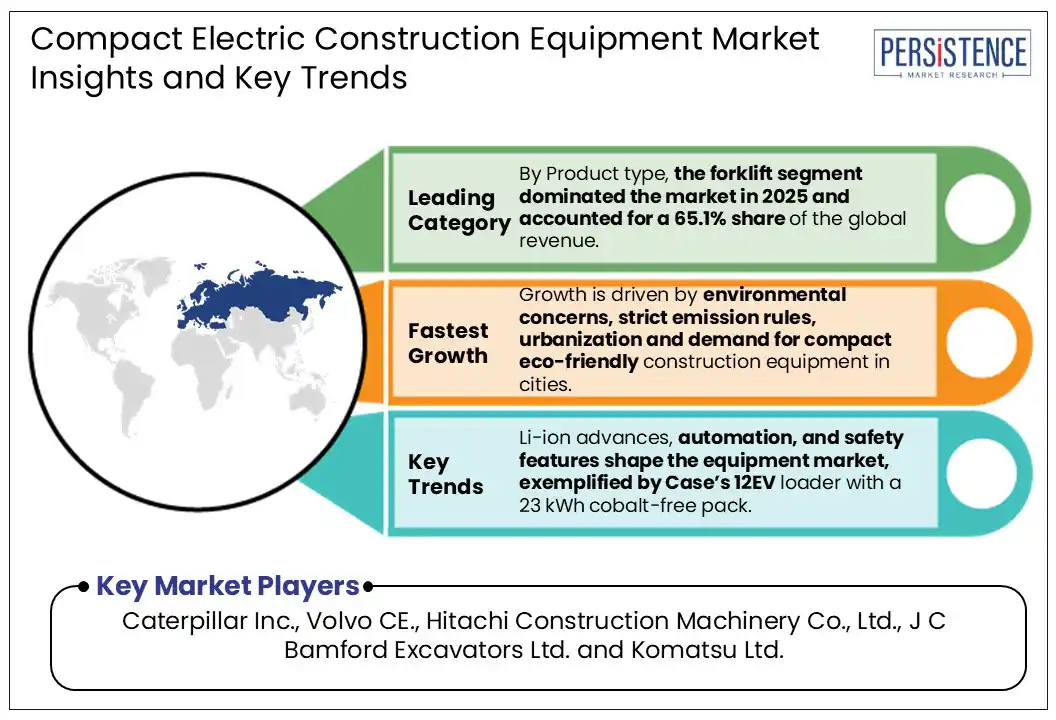ID: PMRREP33192| 210 Pages | 17 Jul 2025 | Format: PDF, Excel, PPT* | Industrial Automation

The global compact electric construction equipment market size is likely to be valued at US$ 66.9 Bn in 2025 and reach US$ 177.8 Bn growing at CAGR of 13.0% during the forecast period 2025 to 2032.
Worldwide, the rise in construction activity and stringent environmental regulations are major factors that have contributed to the surge in sales of compact electric construction equipment over the last few years. Given the rising demand for public infrastructure, readily available buildings, and rising expenditure in industrial expansion operations in urban areas, the compact electric construction equipment market has been expanding in recent years.
The fundamental benefit of compact electrical construction equipment is its versatility and capacity to finish jobs that were possible only with huge machines. Furthermore, it is anticipated that strict government rules about environmental protection promote the use of electric compact wheel loaders and excavators.
The opportunities for compact electric construction equipment are expanding as a result of shifting consumer preferences away from pedal-operated vehicles and toward joystick-operated vehicles, as well as the affordable availability of suspension seats and air conditioning cabins in such vehicles. Another new trend that is very intriguing to most consumers is electric compact equipment with GPS tracking systems, since it makes it simpler for them to monitor their equipment remotely and find it whenever they require it.

Key Industry Highlights:
|
Global Market Attribute |
Key Insights |
|
Compact Electric Construction Equipment Market Size (2025E) |
US$ 66.9 Bn |
|
Market Value Forecast (2032F) |
US$ 177.8 Bn |
|
Projected Growth (CAGR 2025 to 2032) |
13.0% |
|
Historical Market Growth (CAGR 2019 to 2024) |
16.5% |
Continuous advancements in battery technology and electric motor efficiency are at the forefront of driving innovation in the field of compact electric construction equipment. One of the primary areas of focus for manufacturers in this sector is the enhancement of battery life. The goal is to extend the operational duration of compact electric equipment on a single charge, addressing concerns related to productivity and efficiency on construction sites.
Significant improvements in battery performance, charging infrastructure, and energy management systems have made electric compact equipment more practical for daily operations. Modern lithium-ion batteries offer better energy density and faster charging, reducing downtime. Bobcat’s E19e mini excavator, for example, delivers all-day performance with quick recharge options and zero on-site emissions.
Manufacturers such as JCB and Caterpillar are developing smart charging solutions and modular battery packs to support flexible deployment. These advancements reduce the total cost of ownership and enhance machine efficiency.
Electric compact construction equipment generally carries a higher upfront cost compared to traditional diesel-powered machines, often 20-30% more expensive. This price premium poses a significant barrier, especially for small and medium-sized construction firms with limited capital budgets. Although electric machines offer lower operating costs due to reduced fuel and maintenance expenses, the initial investment remains a deterrent. Without clear government policies or incentives to offset these costs, adoption rates remain sluggish. Moreover, these challenges are compounded by the fact that several construction companies operate on tight margins and prioritize short-term cost savings over long-term environmental benefits, slowing market penetration despite the rise in environmental regulations pushing for cleaner equipment.
Recent innovations in battery technology, particularly lithium-ion batteries, and electric motors are significantly enhancing the viability and competitiveness of electric compact construction equipment. Lithium-ion batteries offer higher energy density, longer life spans, and faster charging times, addressing traditional challenges such as limited runtime and power. Advanced battery management systems improve safety and efficiency, while compact, powerful electric motors increase machine performance. These technological improvements enable electric excavators, loaders, and other compact equipment to operate longer and more reliably, reducing operational downtime.
For example, Case Construction Equipment’s 12EV electric wheel loader, launched in 2024 uses a cobalt-free lithium-ion battery, showcasing these advancements. Additionally, hybrid powertrains combining diesel and electric systems are emerging, offering fuel savings and emission reductions in mid-sized and large equipment. This technology-driven opportunity allows manufacturers to expand product portfolios and meet growing demand for efficient, sustainable construction solutions.
As per the analysis, nearly over 65% of the market's revenue was generated by the forklift category in 2025, and it is anticipated that this dominance should last throughout the projected timeline. Industrial applications require an indoor, smooth surface are perfect for compact electric forklift applications. So, electric forklifts are becoming more popular in several end-use sectors since they operate in confined locations, are quiet, and emit no pollutants. Due to the substantial need for lightweight loaders from even the construction companies, the electric compact loader segment is anticipated to expand significantly throughout the forecast period. Additionally, it is anticipated that the launch of new items by competitors promotes further segment growth.
Based on operational weight, until 2025, the sub 5 Ton sector had the highest revenue share and its contribution contributing around 44%. This is due to the rising demand for small-footprint construction equipment that has a less environmental impact and higher operating efficiency. Excavators and electric compact loaders that are lightweight are electrified more quickly than excavators that are medium or huge. As a result, it is anticipated that manufacturers would steadily advance their strategy for electrifying compact excavators of less than 5-ton segments over the projection period.
The above 8-ton segment is expected to witness significant growth in the global market due to high demand from industries for compact electric excavators and loaders that have a high load-carrying capacity. Another factor driving the demand for compact electric construction equipment is the increasing emphasis on safety in the construction industry. Electric equipment operates more quietly than diesel-powered machines, reducing noise pollution and enhancing safety on construction sites.

Asia Pacific is expected to expand at a rapid CAGR of more than 17.0% over the forecast period, which has been attributed to rapid infrastructure development activities in the region. Governments in several Asia Pacific countries, including China, Japan, and South Korea, have introduced initiatives and policies to promote the adoption of electric vehicles and equipment. They are providing incentives and subsidies to encourage the use of eco-friendly products, including compact electric construction equipment.
For instance, the Chinese government signed the recent Regional Comprehensive Economic Partnership (RCEP) free trade agreement with Asia Pacific countries, including Japan, South Korea, Australia, and other smaller South-East Asian economies. The partnership is focused on developing the transportation infrastructure without comprising environmental regulations.
Japan is a leader in technology adoption, and the construction industry seeks cutting-edge solutions. Continuous advancements in battery technology and electric motor efficiency are making compact electric construction equipment an attractive choice for Japanese businesses.
North America is poised to lead the Compact Electric Construction Equipment Market due to strong government investments, stringent environmental regulations, and growing urban infrastructure projects. U.S is the leading market in the development and sales of compact electric construction equipment in current years. By the virtue of the presence of many leading market players in the country and its strong export infrastructure, it is expected to continue its top position in the global market in the coming years.
Leading manufacturers are actively expanding their electric equipment portfolios in the region. For example, Wacker Neuson launched its electric mini excavator EZ17E in 2024, while Volvo Construction Equipment introduced the EC230 electric excavator and L120 electric wheel loader in North America the same year. Case Construction Equipment debuted the 12EV electric wheel loader and 580EV electric backhoe loader in 2024, featuring advanced cobalt-free lithium-ion batteries.
Additionally, Bobcat unveiled a new electric compact track loader at the Equip Expo 2024 in Kentucky. Caterpillar is also investing heavily in electrification, showcasing zero-emission loaders and mini excavators at major events and partnering with key players such as CRH for electric trucks and charging infrastructure.
Europe is at the forefront of implementing stringent environmental regulations aimed at decreasing carbon emissions and controlling air pollution, which have significantly influenced the construction industry. Furthermore, the presence of leading construction equipment manufacturers in the region, who have pioneered electric, battery, and motor technology, thus providing a competitive advantage, is boosting the market growth.
In addition, the heightened environmental awareness among the population in Europe, leading to a strong preference for sustainable and eco-friendly practices in various sectors, including construction, is catalyzing the market growth. Moreover, the imposition of supportive policies by regional governments offering incentives and financial support for the adoption of green technologies, including electric construction equipment, is positively impacting the market growth.
The rapid acceptance of zero-emission technology can be linked to the recent expansion of infrastructure projects in the cities of Norway, Helsinki, Finland, the UK, Denmark, the Netherlands, and Sweden. Developed economies such as Germany, the UK, and France are at the forefront of the demand for compact electric construction equipment.
Major companies are investing in research and development (R&D) to innovate and improve the technology behind electric construction equipment. It includes advancements in battery technology, electric motors, energy efficiency, and the incorporation of smart technologies. Furthermore, key players are expanding their product lines to include a variety of electric construction equipment, such as excavators, loaders, forklifts, and aerial work platforms. Additionally, they are focusing on developing machines that offer comparable or superior performance to traditional diesel-powered equipment. Apart from this, leading manufacturers are entering into partnerships and collaborations with technology companies, battery manufacturers, and other industry players to share expertise, resources, and technology.
The compact electric construction equipment market is estimated to be valued at US$66.9 Bn in 2025.
Increasing demand for quiet, low-noise equipment and lower operating and maintenance costs are the major growth drivers.
The compact electric construction equipment market is estimated to rise at a CAGR of 13.0% through 2032.
Growth in urban infrastructure, zero-emission zones, and fleet electrification by rental companies are key market opportunities.
The global compact electric construction equipment market is dominated by major players such as Caterpillar Inc., Volvo CE., Hitachi Construction Machinery Co., Ltd., J C Bamford Excavators Ltd., and Komatsu Ltd.
|
Report Attribute |
Details |
|
Historical Data/Actuals |
2019 - 2024 |
|
Forecast Period |
2025 - 2032 |
|
Market Analysis |
Value: US$ Bn, Volume: Units |
|
Geographical Coverage |
|
|
Segmental Coverage |
|
|
Competitive Analysis |
|
|
Report Highlights |
|
|
Customization and Pricing |
Available upon request |
By Product type
By Operational Weight
By Region
Delivery Timelines
For more information on this report and its delivery timelines please get in touch with our sales team.
About Author